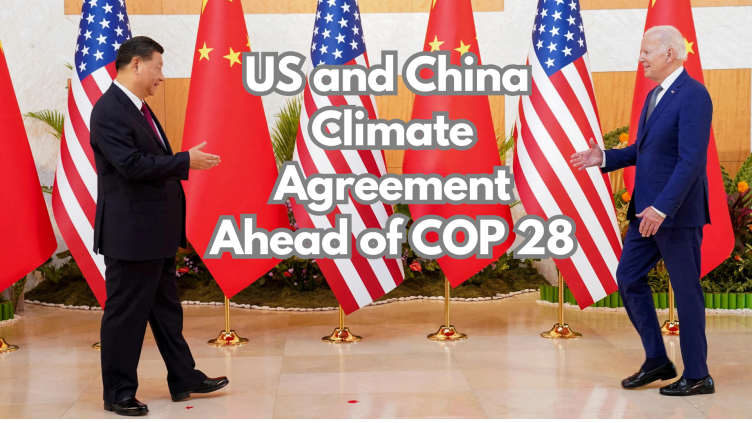Tim Mohin: US and China Climate Agreement Ahead of COP 28

|
Listen to this story:
|
With COP 28 less than two weeks away, an agreement between the US and China builds momentum for a constructive conference. The agreement is to “recall, reaffirm, and commit” to joint efforts in fighting climate change and meeting the goals of the Paris Agreement.
Climate envoys John Kerry and Xie Zhenhua met in Sunnylands, California, before the summit to revive a bilateral climate working group and hammer out some pre-COP agreements. “The Sunnylands statement is a timely effort of aligning the United States and China ahead of COP28,” said Li Shuo, director of the China Climate Hub at the Asia Society.
The US-China agreement covers forestry, circular economy, plastic pollution, and air pollution. From a climate perspective, the most important aspect was the agreement to triple renewable energy capacity this decade. The parties also committed to reducing Methane emissions – a greenhouse gas (GHG) more than 80 times more potent than CO2 over the short term.
The results of the US-China summit helped improve diplomatic relations and will present a collaborative front at COP 28, where the countries will host a methane and non-CO2 gas summit.
Manish Bapna, president of the Natural Resources Defense Council, called the agreement “a foundation of ambition” ahead of the U.N. climate summit in Dubai, adding, “This sends a powerful message of cooperation on the existential challenge of our time.”
Others were wary about the deal, pointing to the glaring omission of any mention of coal usage. Bernice Lee OBE of Chatham House said, “Progress on fossil fuels wasn’t what I expected to see, as they both have constraints… My suspicion is that it has proven to be too difficult to find the form of language that works for both.”
Adding more optimism ahead of COP 28, the EU has pledged to make a “significant contribution” to the world’s first “loss and damage fund” being launched at this year’s event to help developing nations deal with climate disasters. The statement said: “The (EU Climate) Commissioner is ready to announce a substantial financial contribution by the EU and its member states to the loss & damage fund at COP28 in the context of an ambitious outcome at COP28.”
In a Nick of Time

The US and China climate agreement came just in time to build a wave of optimism before COP28. On a sobering note, a series of new reports revealed the extent of the challenge in front of us.
The first report analyzed countries’ decarbonization efforts, finding they are currently insufficient. The report revealed that if countries meet their current climate pledges (and that is a big if), emissions will be 9% higher in 2030 than in 2010. Although this is an improvement from last year, it is still far below the decarbonization needed to keep warming below 1.5°C. “Today’s report shows that governments combined are taking baby steps to avert the climate crisis,” said Simon Stiell of the UN climate change agency.
Similarly, a report from the World Economic Forum and BCG reiterated the insufficient levels of climate action to meet the Paris Agreement. The State of The Climate Report shows that although we need to reduce emissions by 7% year-on-year to meet our 2030 goals, they are still rising.
Related Article: Tim Mohin – Year of Interoperability Continues: CDP Aligns with ESRS
Another report from the UN’s World Meteorological Organization (WMO), The Green House Gas Bulletin, found that in 2022, CO2 levels were 50% above pre-industrial levels for the first time and continued to grow in 2023. Other major GHGs, Methane and Nitrous Oxide, also grew in concentration, with the latter seeing its highest rise ever in 2022.
GHG concentrations like this have not been experienced on Earth for 3-5 million years when the global temperature was 2-3C warmer and sea levels were 10-20 meters higher than today. WMO Secretary-General Petteri Taalas said, “Despite decades of warnings from the scientific community, thousands of pages of reports, and dozens of climate conferences, we are still heading in the wrong direction.”
This Smart Read article is contributed by Tim Mohin, Global Sustainability Leader, BCG. Every week ESG News delivers smart commentary from ESG practitioners and experts to unpack issues of the week. Email here if you are interested in submitting an article [email protected]










